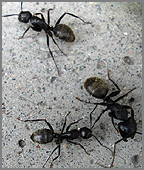All ants live in colonies, consisting of an egg-laying female (queen), short-lived males, and workers (sterile females). The ants you see foraging in your garden or kitchen are workers. Workers that find food communicate with other workers by depositing a chemical message on the substrate as they crawl back to the nest. Although we cannot smell it, this "trail pheromone" sticks to the substrate for long periods of time and helps other ants find the food at the end of the trail.
In the spring, ants develop wings and fly to new locations and invade homes to forage for food or to establish a new nest.
Termites also develop wings and swarm during the spring and look similar to flying ants. Examine them closely to make sure that you have the correct pest! Ants are thin-waisted and have elbowed antennae. Termites have thicker waists and have antennae that resemble strings of tiny beads. You may need a magnifying glass to examine antennal features.
As a group, ants have a wide food range, feeding on sweet foods, greasy materials, starchy substances, wood, and all kinds of plant and animal materials. Part of the reason that ants become a nuisance in our homes is that they often like the same kinds of food that we do. But structures can be threatened by damage from carpenter ants.
 Get Rid of Ants in Your Home
Get Rid of Ants in Your Home